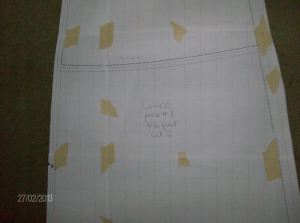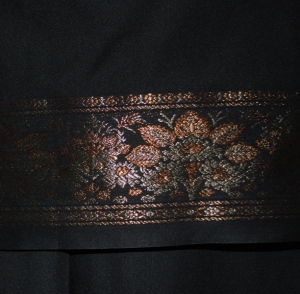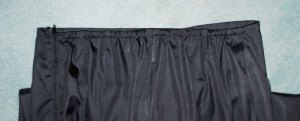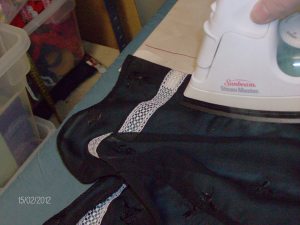This is another formal gown, named Rose Marie, by The Tailor’s Apprentice. As usual, I received it as a .pdf downloadable pattern (e-pattern or digitized pattern). This one had more pieces and took much longer to re-assemble but it was well worth my while!
 Re-assembling the printed sheets and preparing for cutting.
Re-assembling the printed sheets and preparing for cutting.
The pattern allows you to make several outfits: a wedding or evening gown, with or without sleeves, long or short or even with flounced sleeves. You can make it short for day wear, or make it into a two-piece suit, again with a selection of sleeves. I chose a fabric I brought back from a holiday in Curacao. It has a vaguely vintage print on it which I thought suitable for this pattern.
I chose to make a two piece, sleeveless outfit as this fabric is very light cotton and would only be worn in our hot months… and I wasn’t sure there would be quite enough, as it was much narrower than usual. It was the right decision in the end as I had to be a little creative with the top and make a *stepped* front hemline. If you look at the picture of the whole outfit (below), you will see that the center panel of the blouse is a little shorter than the side ones. I didn’t bias hem that piece to prevent *cutting* the visual line across an unflattering width…. 😉
Rose Marie has the typical 1940’s sweetheart neckline which I find so feminine and pretty, especially for summer clothing. As I mentioned, I made it sleeveless. The instructions were very helpful and clear, explaining how to sew up the pattern in true ’40s style, with a side zipper or hooks and eyes or snaps. I opted for a zipper and although I used an invisible zipper, I did follow the instructions to make it hidden under a narrow placket. It does look better that way!
 Bias tape binding both front and back sweetheart necklines.
Bias tape binding both front and back sweetheart necklines.
 The placket over the invisible zipper, on the side of the blouse.
The placket over the invisible zipper, on the side of the blouse.
As for the skirt, I chose to make an elasticized waistband (more comfortable and easier to pull on: my fingers have trouble these days with buttons, hooks and snaps even zipper pulls!) with an uneven hemline: the front being a few inches shorter than the back. There are instructions and indications on the pattern for making the skirt as well as for making a separate top.
In order to make an elasticized waistband, I cut the fabric straight up from the waistline, for 3 1/2 inches. That’s double the width of the elastic plus a little to turn under to make the casing. That seam line is sewn right on the waistline. I call this a *self-waistband*: it has no seams (less bulk too) and uses less fabric than making a facing which has to be sewn onto the skirt and then turned under to make the casing. I really had to be frugal with the fabric!!!
I made an uneven hem line because I wanted the skirt to be longer but because I realized in placing the pattern pieces on the fabric that there just wouldn’t be enough of it, I opted to make it shorter at the front and keep the length I wanted for the back.
One of the pictures included in the pattern shows a day suit of blouse and skirt. It shows how the skirt was trimmed with red (bias binding?) at the skirt hem and the same red is on the neckline and sleeve cuffs. I really liked that detail. I was able to find a light blue bias tape, pre-folded, that matched my fabric and so, I finished many edges with it: the curves of the sweetheart neckline both front and back and the lower hem of the blouse as well as the skirt’s hem. The binding adds a little body to the blouse’s hem and I like that effect.
 Pre-folded Bias Tape made hemming easy. It allowed me to have more length on the skirt as I wasn’t folding up a hem.
Pre-folded Bias Tape made hemming easy. It allowed me to have more length on the skirt as I wasn’t folding up a hem.
The front and back views of my version of Rose-Marie.





























































































